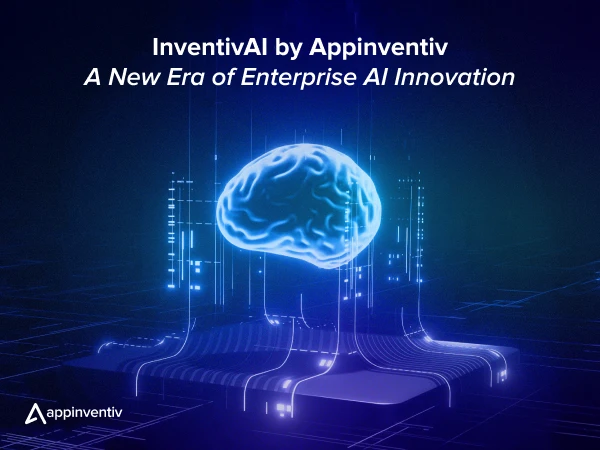- How Cloud Technology is Transforming Oil & Gas Operations
- Upstream: Reducing the Guesswork in Exploration
- Midstream: Keeping the Flow Moving Safely
- Downstream: Optimizing Complex Processes
- Oilfield Services: Creating Connected Operations
- Key Components of Cloud Computing in Oil and Gas
- Compute Services (IaaS)
- Storage Services
- Networking
- Platform as a Service (PaaS)
- Security and Compliance
- Benefits of Cloud Computing in the Oil and Gas Industry
- Advanced Data Analytics and Insights
- Enhanced Computational Power for Simulation and Modeling
- Advanced Security and Compliance Management
- Optimized Resource Management and Cost Control
- Integration with Emerging Technologies
- Operational Agility and Faster Innovation
- Environmental Monitoring and Sustainability Compliance
- Top Use Cases of Cloud Computing in the Oil and Gas Industry
- Real-Time Reservoir Modeling
- Predictive Equipment Maintenance
- Enhanced Environmental Monitoring
- Supply Chain Optimization
- Collaborative Remote Operations
- Advanced Seismic Data Processing
- Machine Learning and Advanced Data Analytics
- Integrated Safety Management Systems
- Real-Time Production Optimization
- Real Examples of Oil and Gas Companies Leveraging Cloud Computing in Their Operations
- Shell’s Digital Transformation with Cloud
- ExxonMobil’s Use of Cloud for Seismic Data Processing
- BP’s Cloud Integration for Optimized Asset Management
- Chevron’s Cloud Solutions for Supply Chain Management
- TotalEnergies’ Cloud-Driven Sustainability Initiatives
- Navigating Challenges and Solutions in Cloud Computing for Oil and Gas
- Data Security Risks
- Data Integration Complexities
- Real-Time Data Processing in Remote Locations
- Managing Complex Geospatial Data
- Ensuring Data Sovereignty in Multiple Jurisdictions
- Future Trends and Emerging Tech in Cloud Computing for Oil and Gas
- Advanced Analytics and AI Integration
- Edge Computing
- Hybrid and Multi-Cloud Environments
- Blockchain
- Quantum Computing
- IoT and Cloud-Enabled Sensors
- 5G Connectivity
- Robotic Process Automation (RPA)
- Cloud-Based Digital Twins
- Cloud-Based Collaboration and Remote Work Solutions
- Cloud-Based Environmental Monitoring
- Augmented and Virtual Reality for Training
- Cloud-Based Asset Management
- Maximize Your Oil Business Potential with Appinventiv’s Cloud Computing Solutions
- FAQs
Key takeaways:
- Cloud computing integrates data across departments, streamlining operations and enabling real-time decision-making.
- Shifting to the cloud reduces IT infrastructure costs and improves resource and maintenance efficiency.
- Cloud platforms manage large datasets, powering predictive analytics and operational optimization.
- Cloud-based systems monitor emissions and resource usage, aiding compliance and supporting sustainability initiatives.
The oil and gas sector faces a serious challenge: drowning in data. Companies routinely handle massive information volumes while trying to keep operations smooth and costs under control. Many existing systems simply can’t cope with this flood of data, creating disconnected workflows, inefficient processes, and expensive IT infrastructure investments. This reality has pushed the industry toward an increasingly important solution: cloud computing.
Cloud technology addresses these core problems directly. Oil and gas companies can now access scalable storage and computing resources that handle enormous datasets effectively. More importantly, this technology delivers real-time insights that improve critical business decisions.
Recent research from Google Cloud reveals that 41% of global technology and business leaders plan to increase their cloud service investments due to current economic conditions. This trend creates substantial opportunities for companies ready to meet the rising demand for cloud solutions.
When companies move their various applications to a single cloud platform, workflows become smoother and teams collaborate better across different locations. Remote monitoring and control capabilities also reduce the need for physical site visits, which cuts downtime and lowers operational costs.
These benefits make cloud technology an essential tool for modern energy companies navigating today’s competitive landscape.
In this blog, we’ll explore the essential components of cloud computing in the oil and gas industry, including its benefits, leading use cases, real-world applications, challenges, and emerging trends. But first, let’s understand how this technology is fundamentally reshaping the way the industry operates.
How Cloud Technology is Transforming Oil & Gas Operations
Over the past decade, oil and gas companies have actively embraced digital technologies. However, a significant challenge remains, many of these systems operate in silos, lacking integration. This fragmentation limits visibility across operations and hinders collaboration between departments. The complexity has only grown with the rise of remote work and geographically dispersed teams.
Cloud technology is emerging as a transformative solution, enabling companies to unify their disconnected systems and streamline operations across the entire oil and gas value chain. Here’s how various segments of the industry are leveraging cloud solutions to drive efficiency and innovation:
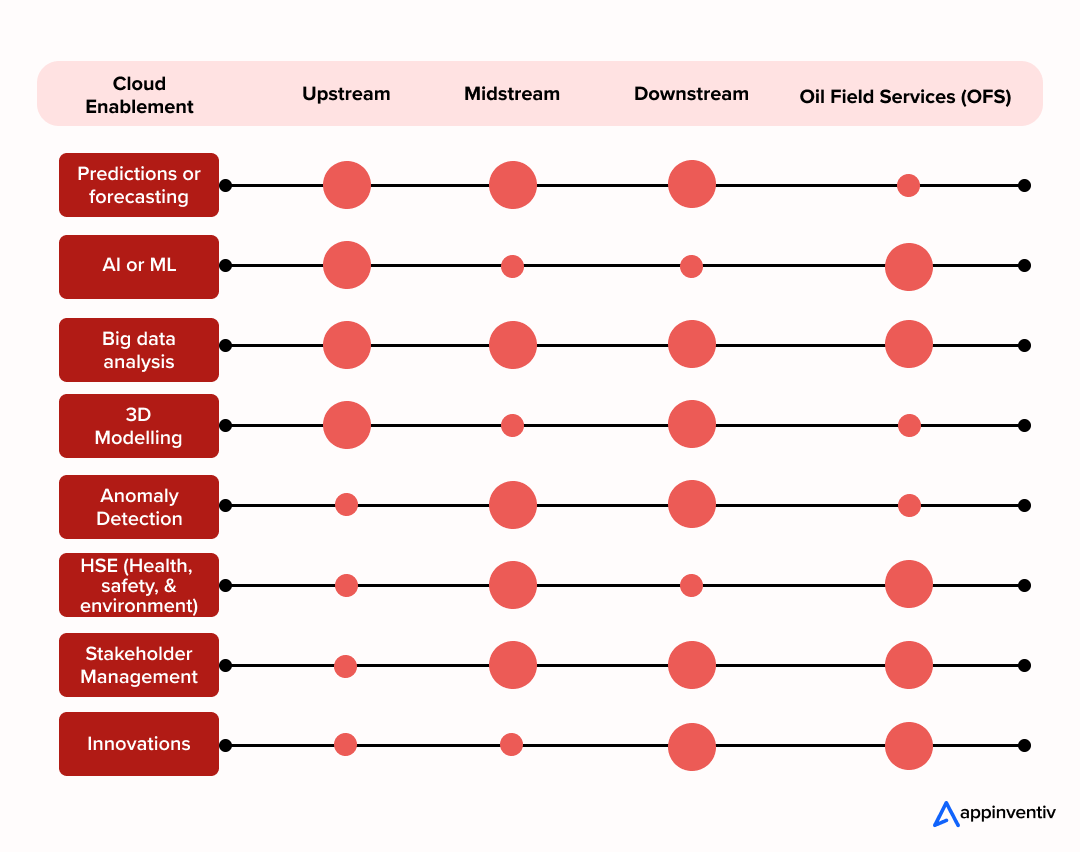
Upstream: Reducing the Guesswork in Exploration
Identifying new oil reserves is a capital-intensive and high-risk endeavor. Exploration projects can cost millions, often with no guaranteed returns, driving upstream operators to seek innovative ways to improve success rates. While vast volumes of geological data, seismic surveys, core samples, and historical drilling records are available, extracting meaningful insights from this information demands substantial computational power.
Cloud platforms are transforming upstream operations by addressing these challenges head-on. They offer the high-performance computing capabilities needed to run complex geological models that previously took weeks, now processed in a matter of days.
These systems can also identify patterns across similar formations to fill data gaps, enhancing decision-making. Most critically, cloud solutions accelerate the generation of detailed 3D subsurface models, enabling geologists to visualize underground formations with greater accuracy and speed.
Also Read: Decoding Upstream Oil and Gas Software Development
Midstream: Keeping the Flow Moving Safely
The midstream sector has been on a building spree, laying thousands of miles of new pipeline to handle increased production from shale fields. But more infrastructure means more potential points of failure, and pipeline operators know that even small leaks can quickly turn into expensive disasters.
Cloud technology is becoming essential for managing this expanding network. Companies are utilizing it to support predictive maintenance programs that identify potential problems before they lead to shutdowns. Real-time monitoring systems hosted in the cloud can track everything from pressure fluctuations to unusual vibrations across thousands of miles of pipeline.
The technology also helps with the human side of operations. Pipeline companies deal with numerous stakeholders, including regulators, landowners, and emergency responders, and cloud-based platforms make it easier to keep everyone informed and coordinated. When disruptions occur, having real-time data and communication tools enables operators to respond more quickly and minimize the impact on customers.
Downstream: Optimizing Complex Processes
Refineries are incredibly complex operations where small efficiency gains can translate into millions of dollars in savings. Downstream companies are using cloud computing to optimize everything from crude oil processing to the final distribution of gasoline and petrochemicals.
The technology excels at handling the massive amounts of data that refineries generate every day. By analyzing this information, companies can fine-tune their processes to get more valuable products from each barrel of crude oil. They’re also using cloud platforms to support newer technologies like 3D printing, which is proving useful for creating custom parts and reducing maintenance downtime.
Market intelligence is another area where cloud computing is making a difference. Companies need to understand demand patterns and pricing trends to make smart decisions about where to invest and what products to focus on. This is especially important as the energy landscape shifts toward renewables and traditional demand patterns begin to change.
Oilfield Services: Creating Connected Operations
Most energy-based businesses are utilizing cloud technology to create what the industry refers to as “digital oilfields” – operations where data flows seamlessly between various systems and locations. This connectivity enables better real-time decision-making and ensures that safety and environmental considerations are always at the forefront.
The supply chain benefits are particularly significant. Oilfield service companies typically work with dozens of suppliers and contractors on any given project. Cloud-based systems make it easier to coordinate deliveries, track equipment, and ensure that everyone has access to the latest project information.
The outcome is: more synchronized operations, marked by enhanced efficiency, transparency, and accountability. These qualities are becoming increasingly critical as the industry navigates heightened scrutiny around environmental impact, regulatory compliance, and safety performance.
Key Components of Cloud Computing in Oil and Gas
Cloud computing is revolutionizing the oil and gas industry by turning vast data into actionable insights that fuel innovation. It enables seamless collaboration across global teams, driving smarter decisions in real-time and optimizing operations from exploration to production. With advanced analytics at its core, cloud technology is not just enhancing efficiency—it’s fundamentally changing how the industry operates, pushing the boundaries of what’s possible in energy exploration and management.
Cloud computing is built on several key components that work together to deliver scalable, flexible, and efficient computing resources. Here’s a breakdown of its main components:
Compute Services (IaaS)
At the core of cloud computing, compute services provide virtual machines and processing power on demand. These services are the backbone of cloud infrastructure, enabling users to run applications, manage workloads, and scale resources efficiently. Examples include AWS EC2, Google Compute Engine, and Microsoft Azure Virtual Machines.
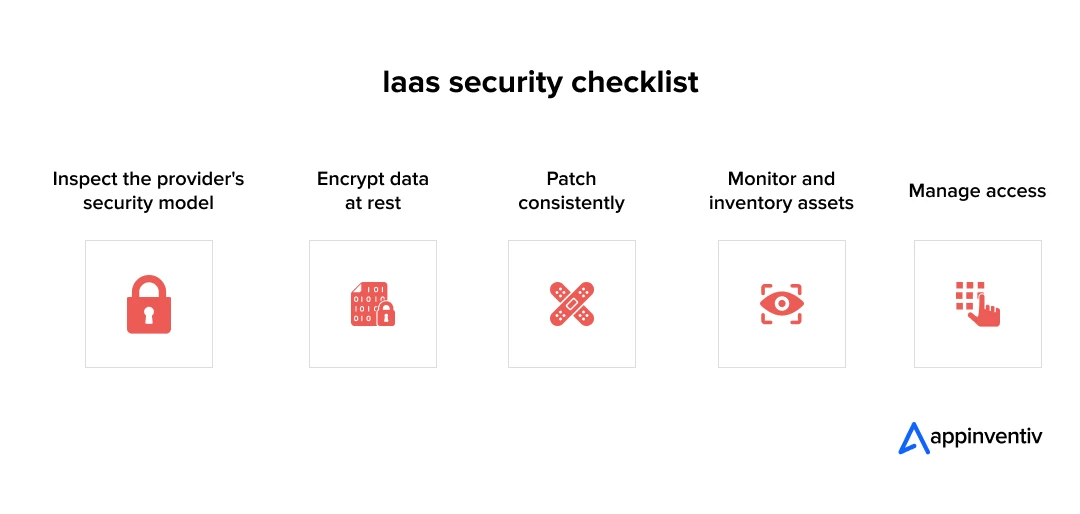
Storage Services
Cloud storage offers scalable, durable, and highly available data storage solutions. It allows businesses to store and retrieve data from anywhere, with redundancy across multiple geographic locations to ensure data integrity and availability. Key services include AWS S3, Google Cloud Storage, and Azure Blob Storage.
Networking
Cloud networking underpins the connectivity and communication within cloud environments. It includes virtual networks, load balancers, and Content Delivery Networks (CDNs) that optimize the delivery of data and applications globally, ensuring low latency and high availability. Networking services are crucial for integrating cloud resources and efficiently distributing content.
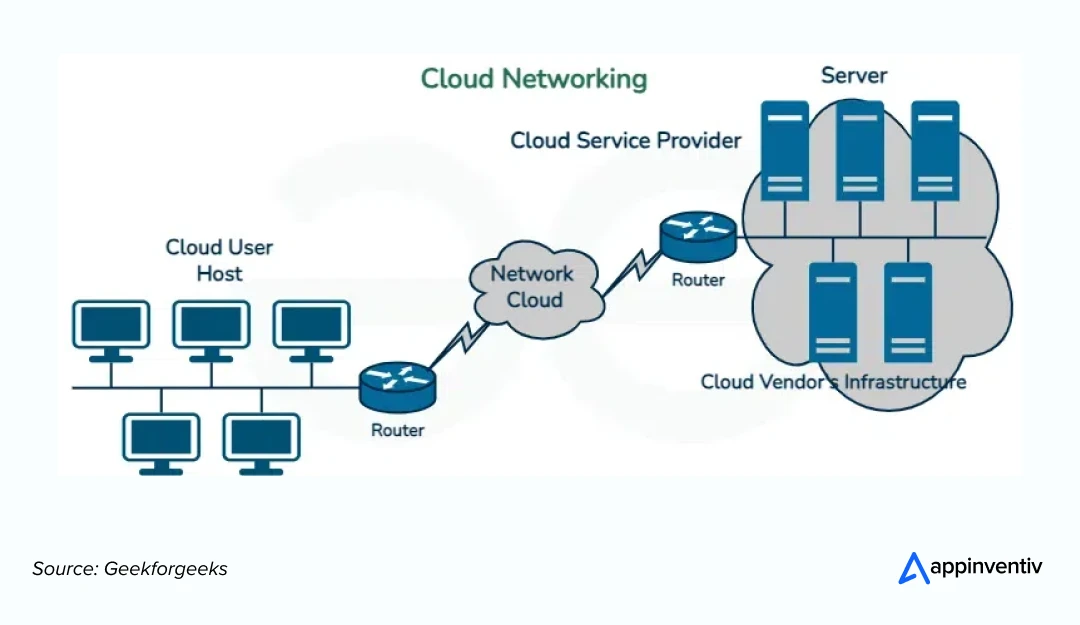
Platform as a Service (PaaS)
PaaS provides a comprehensive environment for developers to build, deploy, and manage applications without worrying about the underlying infrastructure. This pillar includes development tools, middleware, and database management systems, enabling rapid application development and deployment. Examples include Google App Engine and Azure App Service.
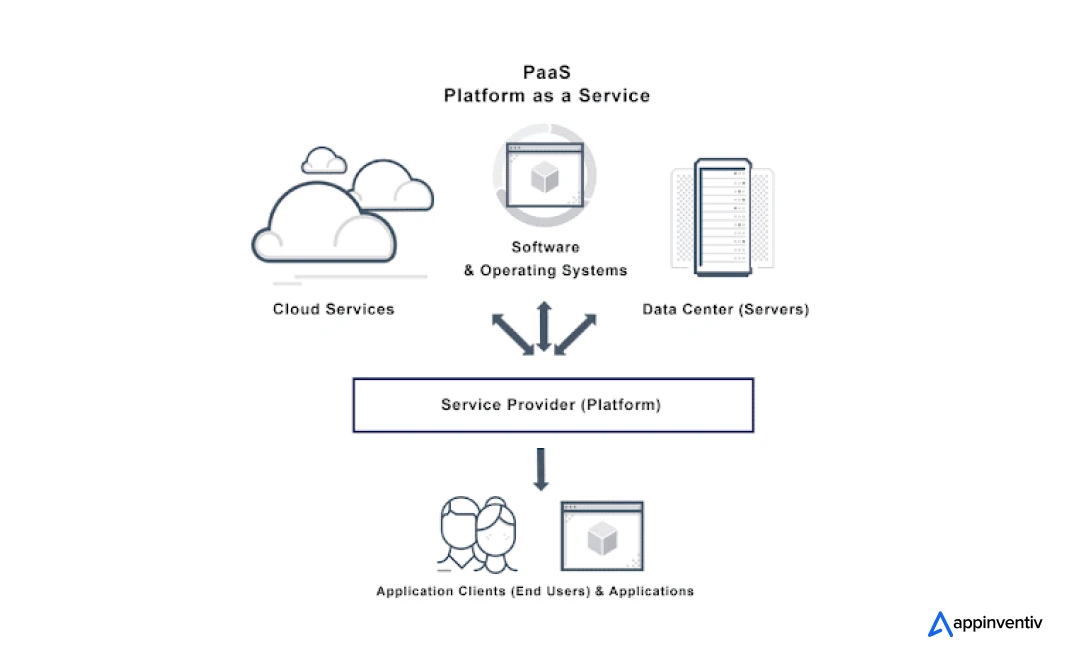
Security and Compliance
Security in the cloud is paramount, encompassing a wide array of tools and practices such as encryption, identity and access management (IAM), and network security protocols. Compliance with industry standards and regulations ensures that cloud environments meet necessary legal and organizational requirements, safeguarding sensitive data and maintaining trust.
These five pillars form the foundation of cloud computing, enabling it to deliver scalable, secure, and highly available services to organizations worldwide.
Benefits of Cloud Computing in the Oil and Gas Industry
The importance of cloud computing in the oil and gas industry lies in its ability to enhance data management, streamline operations, and drive innovation through scalable and flexible technology solutions. Let’s explore how cloud computing is reshaping the oil and gas sector, analyzing its numerous benefits.
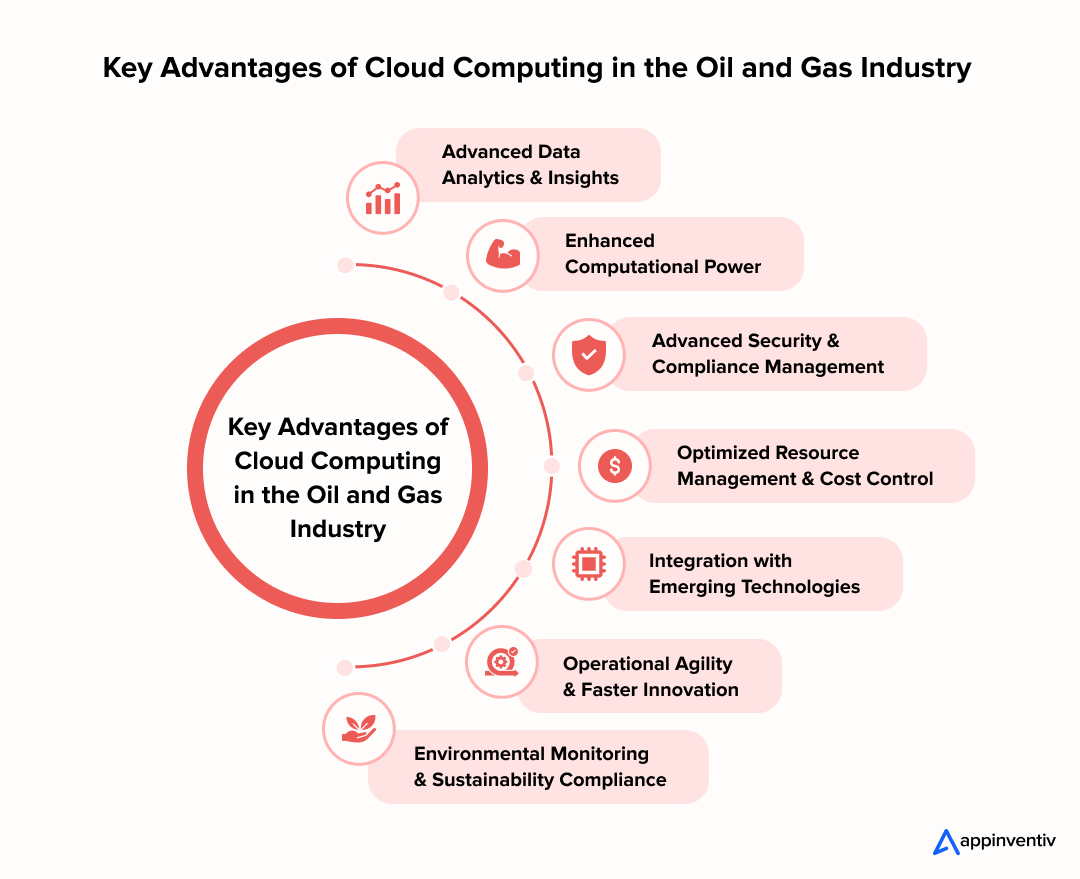
Advanced Data Analytics and Insights
Oil and gas cloud solutions enable sophisticated data analytics and insights that are critical for the sector. By leveraging the cloud’s computational power and storage capabilities, companies can perform complex data analysis at scale. This includes:
- Real-Time Data Processing: The cloud enables the real-time processing of data from various sources, including sensors and IoT devices, in drilling operations. This real-time capability enables the monitoring and optimization of drilling performance, the detection of anomalies, and the swift response to operational issues.
- Predictive Analytics: With access to vast amounts of historical and real-time data, cloud-based analytics platforms can deploy machine learning algorithms to forecast equipment failures, predict reservoir behavior, and optimize production schedules. This predictive capability reduces downtime and enhances decision-making.
- Geospatial Data Analysis: Cloud computing in the oil and gas industry provides powerful tools for analyzing geospatial data, which is essential for exploration and production activities. Advanced GIS (Geographic Information Systems) and remote sensing technologies can be utilized to create detailed maps, analyze geological formations, and plan drilling operations more effectively.

Enhanced Computational Power for Simulation and Modeling
The oil and gas industry relies heavily on simulation and modeling for reservoir management, seismic analysis, and engineering design. Cloud computing offers significant advantages in this area:
- High-Performance Computing (HPC): The cloud provides access to HPC resources that can handle complex simulations and models, such as reservoir simulations and seismic data processing. These resources are scalable, allowing companies to run large-scale simulations without investing in on-premises hardware.
- Elastic Resource Allocation: Cloud platforms offer elastic resource allocation, enabling users to dynamically allocate computational resources as needed. This flexibility is particularly beneficial for running intensive simulations during peak periods, such as exploration campaigns or large-scale production planning.
- Collaborative Modeling: Cloud-based modeling tools allow for collaborative development and refinement of models. Teams from different locations can work together in real-time, integrating various data sources and refining models more efficiently.
Advanced Security and Compliance Management
Security and compliance are critical concerns in the oil and gas industry, given the sensitive nature of the data and regulatory requirements. Cloud computing enhances security and compliance management through:
- Advanced Encryption Techniques: Cloud providers implement robust encryption protocols for data at rest and in transit. This ensures that sensitive information, such as proprietary exploration data and operational details, is protected against unauthorized access and cyber threats.
- Comprehensive Security Frameworks: Leading cloud platforms offer comprehensive security frameworks, including multi-factor authentication, identity management, and access control. These frameworks help manage user access and safeguard critical assets.
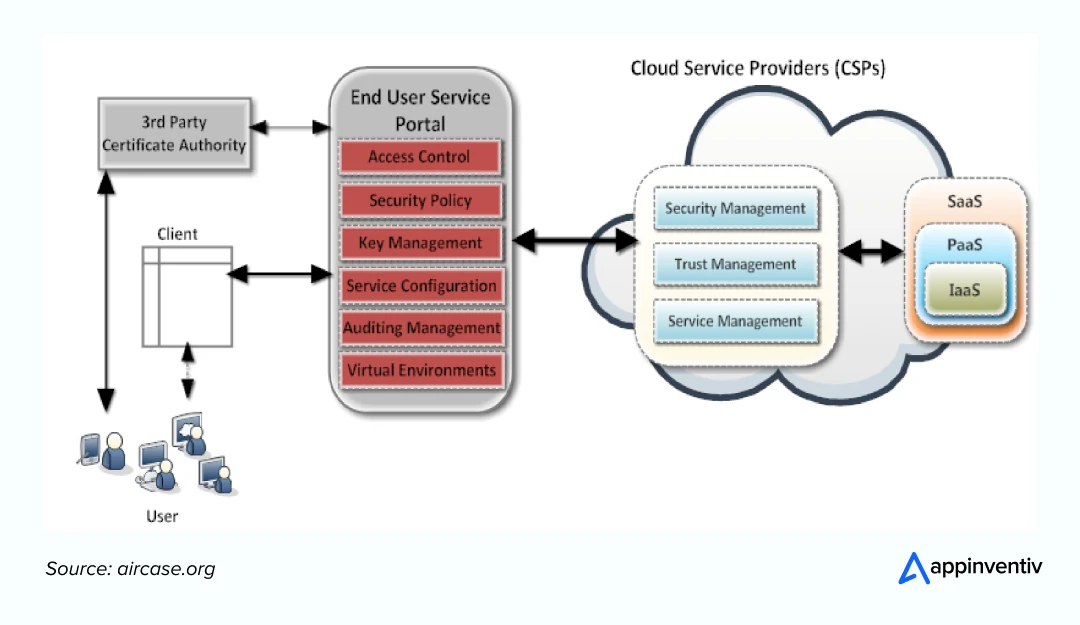
- Regulatory Compliance: Cloud providers often comply with industry-specific regulations and standards, such as GDPR and ISO/IEC 27001. They offer tools and features that help oil and gas companies meet compliance requirements, such as audit logs, data sovereignty controls, and regular security assessments.
Optimized Resource Management and Cost Control
Efficient resource management and cost control are crucial for maximizing profitability in the oil and gas industry. Cloud computing provides advanced tools for achieving these goals:
- Dynamic Resource Allocation: Cloud platforms allow for the dynamic allocation of computing resources based on demand. This means that resources can be scaled up or down automatically in response to workload changes, optimizing operational costs and resource utilization.
- Cost Management Tools: Cloud computing in the oil and gas industry offers detailed cost management and monitoring tools that provide insights into resource usage and spending. This helps companies track expenses, identify cost-saving opportunities, and manage budgets more effectively.
- Pay-As-You-Go Pricing: The cloud’s pay-as-you-go pricing model allows companies to pay only for the resources they use. This reduces the need for large upfront investments in hardware and infrastructure, aligning costs with actual usage and operational needs.
Integration with Emerging Technologies
The cloud facilitates the integration of emerging technologies that drive innovation in the oil and gas sector:
- Internet of Things (IoT): Cloud platforms support the integration of IoT devices, which are increasingly used in monitoring equipment, environmental conditions, and operational parameters. The cloud provides the infrastructure needed to handle the data generated by these devices and enables real-time monitoring and control.
- Artificial Intelligence (AI) and Machine Learning (ML): Cloud computing in oil and gas enables the deployment of artificial intelligence and machine learning models for various applications, including automated decision-making, anomaly detection, and process optimization. These technologies enhance operational efficiency and enable more informed decision-making.
- Blockchain Technology: The cloud supports the use of blockchain technology for secure and transparent data management. Blockchain can be used for tracking supply chains, verifying transactions, and ensuring the integrity of data.
- Digital Twins: Cloud computing enables a real-time digital twin of physical assets, allowing operators to simulate changes, test optimizations, and predict outcomes with reduced risk and cost.
- Edge Computing Integration: In remote oilfields, edge computing connected to cloud platforms ensures real-time processing of data locally, with aggregated insights delivered to central systems, minimizing latency and enabling prompt decision-making in the field.
Operational Agility and Faster Innovation
One of the biggest strengths of cloud solutions in the oil and gas industry is how they support faster and more flexible operations.
- Quick Experimentation: Teams can easily create test environments to try out new tools or workflows without disrupting any of the ongoing systems.
- Smooth Updates: Software improvements and fixes can be rolled out remotely—no need to pause operations or wait for lengthy maintenance windows.
- Easy Expansion: Whether it’s opening a new site or entering a different region, cloud infrastructure makes it quicker and easier to scale without heavy upfront investments.
- With growing emphasis on sustainability, cloud technologies play a key role in helping oil and gas companies stay on top of their environmental responsibilities.
Environmental Monitoring and Sustainability Compliance
With growing emphasis on sustainability, cloud technologies play a key role in helping oil and gas companies stay on top of their environmental responsibilities.
- Real-Time Emissions Tracking: Companies can monitor emissions as they happen using connected systems, helping them stay accountable and proactive.
- Reducing Waste: Cloud-powered insights help identify areas where energy is being wasted, such as excess flaring, so companies can make informed changes.
- Simplified Reporting: Keeping track of carbon credits and meeting sustainability goals becomes more manageable with tools that organize and automate the reporting process.
Top Use Cases of Cloud Computing in the Oil and Gas Industry
Let’s examine how cloud computing technology enables the oil and gas industry to elevate operations, boost productivity, and drive innovation across various sectors.
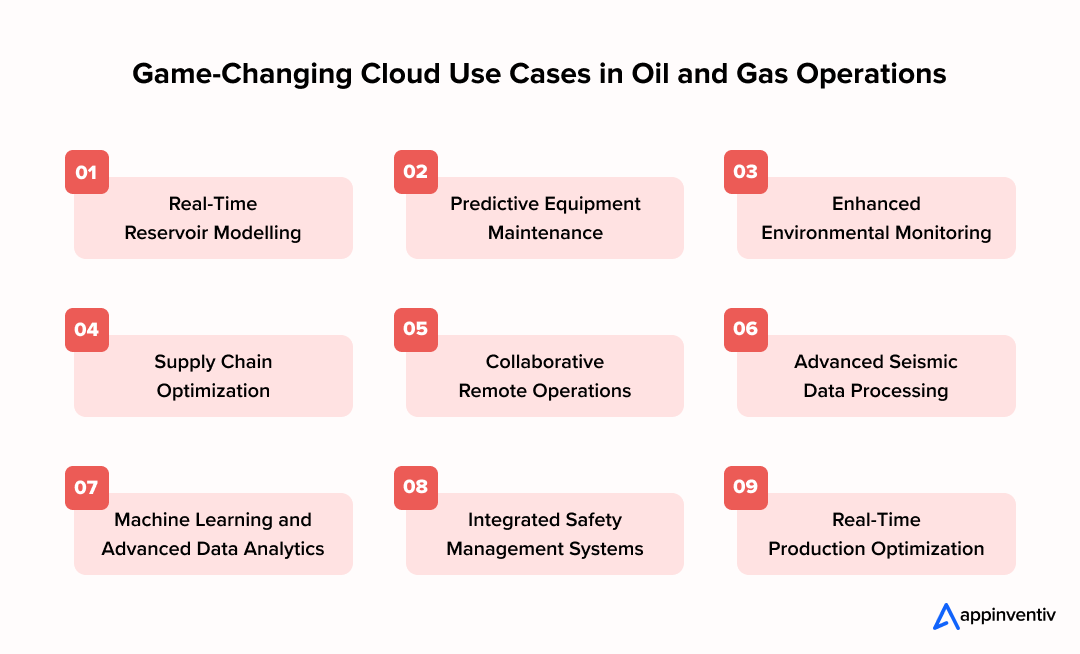
Real-Time Reservoir Modeling
Cloud computing enables the integration and analysis of vast amounts of geological and seismic data to create real-time reservoir models. This allows geoscientists to simulate different extraction scenarios, optimize drilling strategies, and enhance oil recovery rates with greater accuracy.
Predictive Equipment Maintenance
By leveraging cloud-based IoT and big data analytics, oil and gas companies can monitor the health of drilling rigs, pipelines, and other critical infrastructure. Predictive maintenance algorithms can analyze equipment data to forecast potential failures, significantly reducing downtime and maintenance costs, thereby providing a sense of security and confidence in the operations.
Enhanced Environmental Monitoring
Cloud computing facilitates the deployment of advanced environmental monitoring systems that track emissions, water usage, and other environmental factors in real-time. This helps companies comply with regulations, reduce their carbon footprint, and mitigate environmental risks.
Supply Chain Optimization
Cloud platforms can integrate data from various supply chain sources, such as suppliers, manufacturers, and logistics providers, to optimize the procurement and distribution of materials. This results in reduced costs, improved inventory management, and more efficient operations across the supply chain, making the audience feel more productive and effective in their roles.
Collaborative Remote Operations
Cloud computing in the oil and gas industry allows for seamless collaboration between remote teams and on-site engineers in oil and gas operations. Using cloud-based platforms, teams can share real-time data, video feeds, and project updates, enabling experts from different locations to make informed decisions quickly. This enhances operational efficiency, especially in remote or offshore locations, by reducing the need for on-site presence and accelerating decision-making processes.
Advanced Seismic Data Processing
Cloud infrastructure provides the enormous computing resources required to process seismic surveys more efficiently than on-premise systems. Larger datasets can be analyzed more quickly, allowing firms to obtain better subsurface images and identify hydrocarbon reserves with greater integrity where relevant. The technology is especially helpful in deepwater and unconventional resource exploration.
Machine Learning and Advanced Data Analytics
With cloud computing, oil and gas companies are able to implement advanced analytics and machine learning functions throughout their operations. Such tools have the potential to detect patterns in production statistics, as well as to optimize drilling parameters in real-time and forecast market trends. The elasticity in the cloud infrastructure can enable firms to handle increasingly larger chunks of data as their businesses expand.
Integrated Safety Management Systems
Cloud-based safety platforms can gather safety data across multiple sources, including incident reports, equipment monitoring, and personnel tracking systems. This holistic practice enables companies to monitor safety trends, take relevant preventive measures, and ensure compliance with safety laws at all operational sites.
Real-Time Production Optimization
Cloud computing technology enables the continuous monitoring and optimization of production processes across multiple wells and facilities. They enable automated systems to adjust the parameters of the production value stream in real-time, taking into account varying situations in the reservoir and market, as well as equipment performance, to achieve the greatest output at the lowest operational expense.
Real Examples of Oil and Gas Companies Leveraging Cloud Computing in Their Operations
In recent years, leading oil and gas companies like Shell and other industry giants have been increasingly leveraging cloud computing to drive innovation and efficiency. The use of cloud computing in the oil and gas industry has become essential for optimizing operations, enhancing data analysis, and reducing costs. By adopting cloud solutions for oil and gas, they are setting new standards for operational excellence and sustainability in the sector.
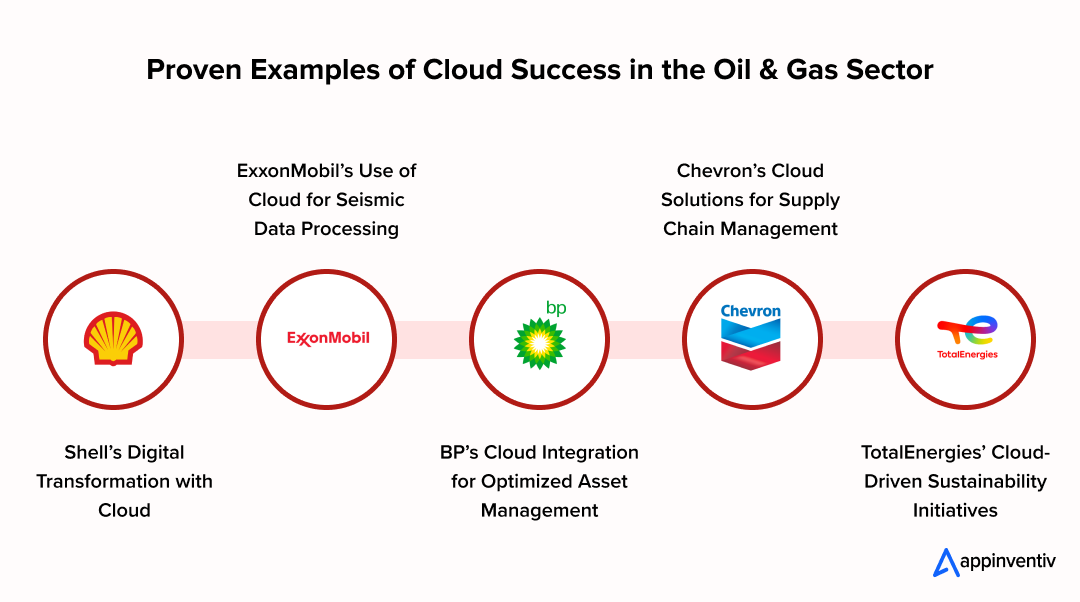
Shell’s Digital Transformation with Cloud
Shell has been heavily investing in cloud computing as part of its digital transformation strategy. The company uses cloud platforms to integrate and analyze data from multiple sources, driving efficiencies in upstream and downstream operations.
Shell’s partnership with Microsoft Azure, for instance, allows for advanced data analytics and real-time monitoring of their global operations, enabling faster responses to market changes and operational challenges.
ExxonMobil’s Use of Cloud for Seismic Data Processing
ExxonMobil has turned to cloud computing to manage and analyze massive amounts of seismic data. By leveraging cloud platforms, the company can process and interpret seismic data faster, leading to more accurate exploration and drilling decisions. This move not only reduces costs but also shortens the time to market for new oil fields.
BP’s Cloud Integration for Optimized Asset Management
BP has embraced cloud computing in the oil and gas industry to improve asset management and increase operational efficiency. With cloud-based platforms, BP can effectively track its physical assets, optimize maintenance schedules, and minimize downtime. This digital transformation allows BP to maximize the lifecycle value of its assets while keeping costs low.
Chevron’s Cloud Solutions for Supply Chain Management
Chevron has adopted cloud computing for oil and gas to enhance its supply chain management and streamline logistics operations. By using cloud platforms, Chevron can better control the flow of materials and resources, improving inventory management and reducing delays. Additionally, the flexibility of the cloud allows Chevron to scale operations to meet real-time demand, boosting supply chain responsiveness.
TotalEnergies’ Cloud-Driven Sustainability Initiatives
TotalEnergies is using oil and gas cloud computing to advance its sustainability initiatives. By integrating cloud-based data analytics, TotalEnergies can optimize energy production processes, making resource extraction more sustainable. The company leverages cloud computing in the oil and gas sector to track environmental impacts in real time, ensuring operations meet sustainability standards and regulatory requirements.
These examples demonstrate how cloud solutions are transforming the use cases of cloud computing in the oil and gas industry, helping companies optimize operations, improve efficiency, and achieve sustainability goals.
Navigating Challenges and Solutions in Cloud Computing for Oil and Gas
When businesses in the oil and gas industry consider adopting cloud computing technology, several crucial factors come into play. These considerations are essential for ensuring a seamless and responsible transition, maximizing the benefits of cloud solutions while maintaining operational integrity.
Key challenges of cloud computing in oil and gas include data security, compliance, and the integration with existing legacy systems. Addressing these challenges effectively can help optimize the impact of cloud technology in the oil and gas industry.
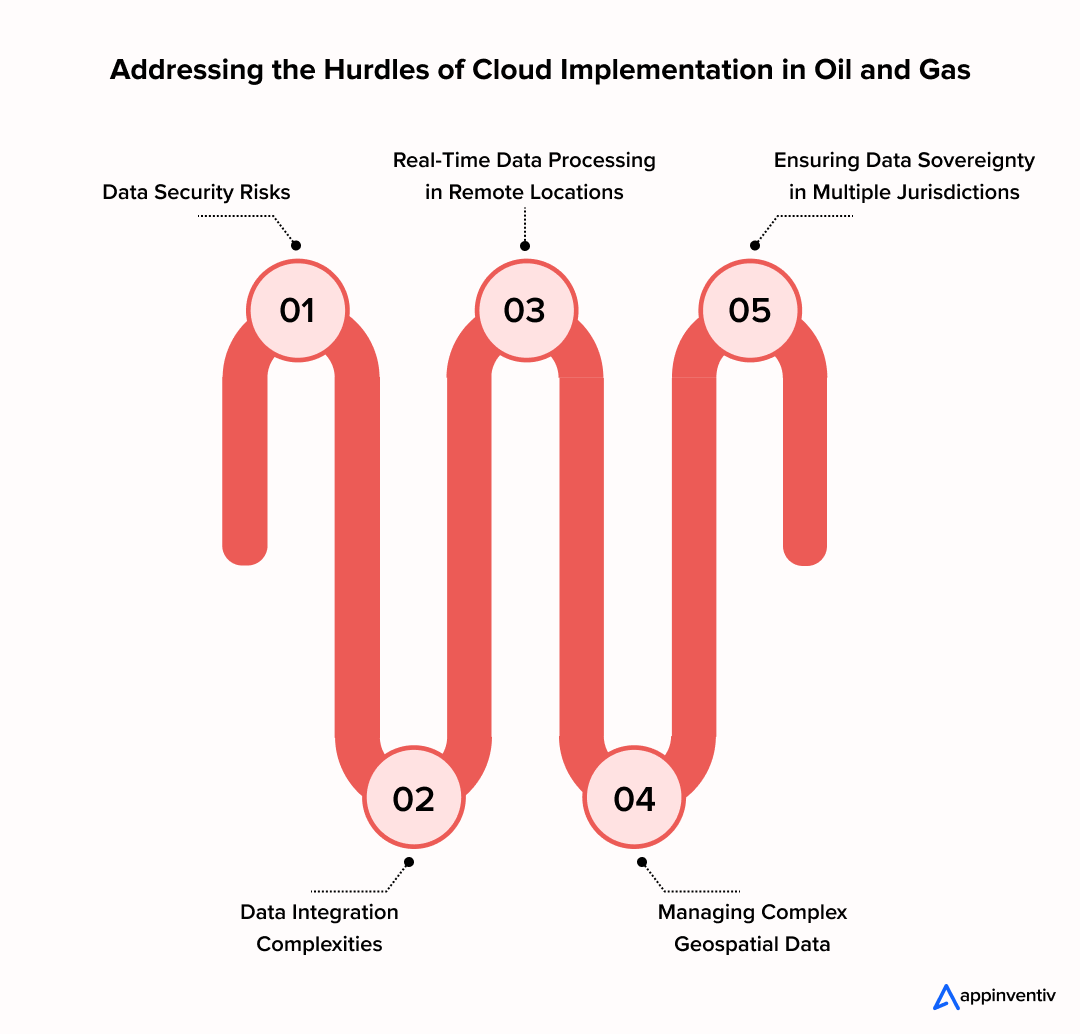
Data Security Risks
Oil and gas companies adopting cloud computing face significant challenges related to data security. The transition to cloud-based solutions introduces vulnerabilities that can expose sensitive operational data to cyber threats, leading to potential breaches and unauthorized access.
Solution:
Companies should implement robust security measures to mitigate these risks, including encryption, multi-factor authentication, and regular security audits. Partnering with cloud service providers that offer advanced security features and compliance with industry regulations is crucial for safeguarding data.
Data Integration Complexities
Integrating cloud computing with existing on-premises systems and other technologies can be complex. Oil and gas companies often operate with legacy systems, and seamless integration with the cloud may present technical challenges.
Solution:
Companies should consider hybrid cloud solutions that allow for a gradual transition. Engaging with cloud providers that offer specialized integration services can help in aligning cloud solutions with existing infrastructure, ensuring a smoother transition.
Real-Time Data Processing in Remote Locations
The oil and gas industry often operates in remote and harsh environments where connectivity is limited. Cloud computing requires reliable internet connections for real-time data processing, which can be difficult to achieve in these locations.
Solution:
To address this challenge, companies can implement edge computing solutions that process data locally at remote sites before syncing with the cloud. This approach reduces latency and ensures continuous operations even in areas with poor connectivity.
Managing Complex Geospatial Data
Oil and gas operations generate vast amounts of complex geospatial data, including seismic data, drilling maps, and reservoir simulations. Moving and processing this data in the cloud can be a significant challenge due to its size and complexity.
Solution:
Businesses should leverage cloud platforms that offer specialized services for geospatial data management. These services include optimized data storage, high-performance computing capabilities, and tools specifically designed for handling large-scale geospatial datasets.
Ensuring Data Sovereignty in Multiple Jurisdictions
The oil and gas industry operates globally, with data generated across multiple jurisdictions. Ensuring data sovereignty—where data is stored and processed according to the laws of each jurisdiction—can be challenging when using cloud services that may not have data centers in every region.
Solution:
Companies should work with cloud providers that offer regional data centers and provide clear data sovereignty assurances. Deploying cloud services in specific regions where operations occur ensures compliance with local data protection laws and minimizes legal risks.
Resolve the challenges within your oil & gas operations and be at the forefront of this industry.
Future Trends and Emerging Tech in Cloud Computing for Oil and Gas
The impacts of cloud technology in oil and gas are profound, driving efficiency, better decision-making, and enhanced safety. Emerging cloud computing industry trends, such as edge computing and AI integration, promise to further transform and reshape the sector’s future. Let’s explore what the future of cloud computing in the oil and gas industry beholds!
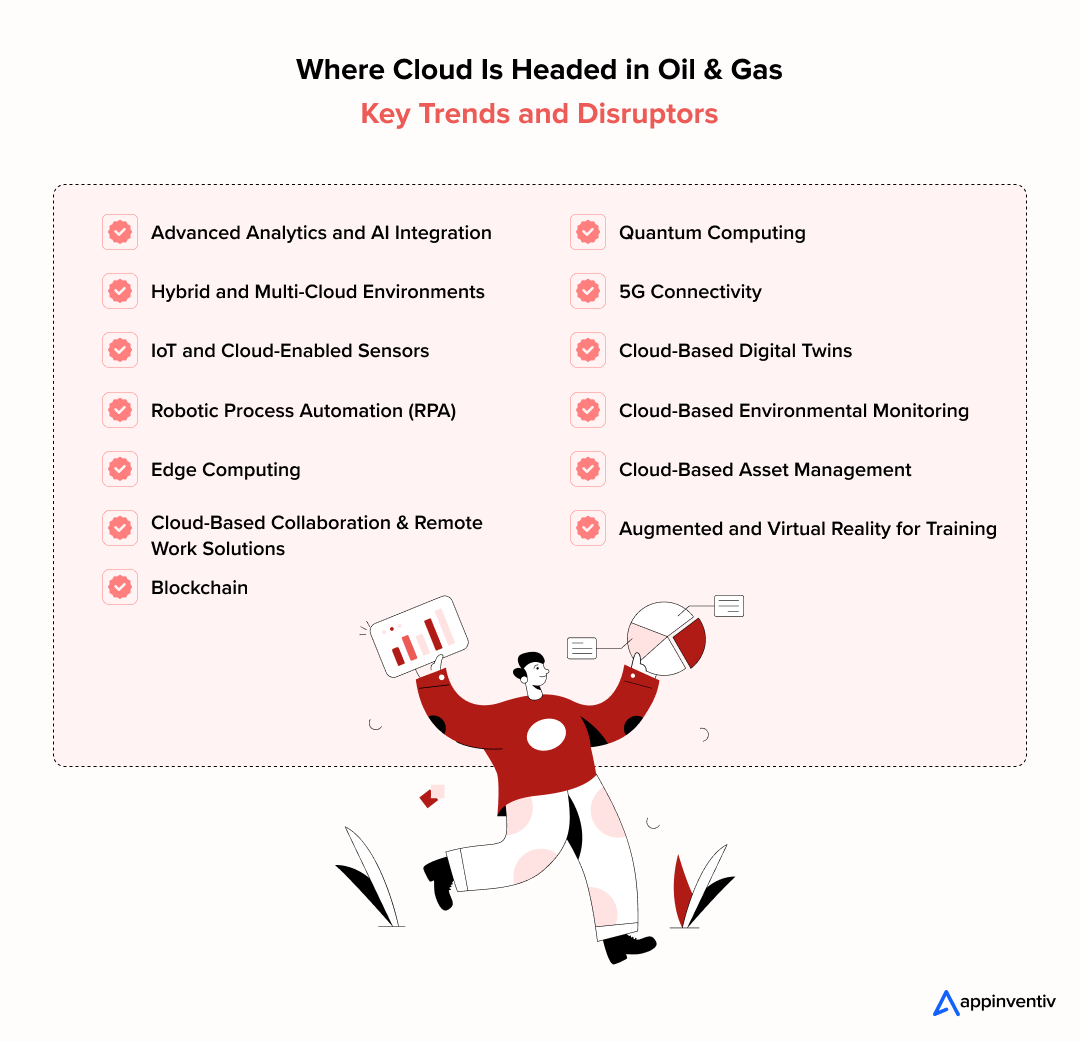
Advanced Analytics and AI Integration
Advanced Analytics and AI Integration will lead to more precise predictive analytics and real-time data analysis, enhancing equipment maintenance and operational efficiency. With AI-driven insights, oil and gas companies can anticipate equipment failures before they occur and optimize their operations for better performance.
Edge Computing
Edge Computing will enable decentralized data processing, reducing latency and bandwidth usage by handling data closer to the source. This technology will improve the performance of cloud applications by allowing for more efficient data collection and analysis directly at the edge of the network, such as on drilling rigs and remote sensors.
Hybrid and Multi-Cloud Environments
Hybrid and Multi-Cloud Environments will offer flexible resource management and improved disaster recovery options by leveraging the strengths of various cloud providers. This approach will allow oil and gas companies to utilize a combination of private and public clouds, optimizing their operations while maintaining control over sensitive data.
Blockchain
Blockchain will enhance data security and integrity, providing secure transactions and increased transparency in supply chain management. By implementing blockchain technology, oil and gas companies can ensure that data exchanges are tamper-proof and that their supply chains are more traceable and transparent.
Quantum Computing
Quantum Computing will address complex simulations and optimization challenges with unprecedented efficiency. This technology will revolutionize exploration and drilling processes by solving problems that are currently beyond the reach of classical computing, and will advance data encryption methods for better security.
IoT and Cloud-Enabled Sensors
Cloud computing in the oil and gas sector is bringing the power of IoT to the forefront. By deploying real-time, cloud-enabled sensors on drilling sites, rigs, and refineries, companies can monitor operational data like temperature, pressure, and flow rates. This allows for predictive maintenance, minimizing downtime and optimizing resource usage.
5G Connectivity
The arrival of 5G will boost cloud computing in the oil and gas industry by offering faster, more reliable data transfer across remote sites. The improved connectivity will support more real-time data sharing between teams and increase operational visibility, enabling better decision-making in critical situations.
Robotic Process Automation (RPA)
RPA, when integrated with cloud computing in the oil and gas industry, can take it to the next level by automating routine, manual tasks such as inventory management and invoice processing. With RPA technology, companies can reduce human error and streamline their operations, boosting efficiency and freeing up resources for more strategic initiatives.
Cloud-Based Digital Twins
Cloud-based digital twins in the oil and gas industry are now quickly gaining traction. These digital models offer real-time insights into the health and performance of physical assets like drilling rigs, pipelines, and refineries. By simulating their behavior, oil and gas companies can optimize maintenance schedules, predict failures, and extend the lifespan of costly equipment.
Cloud-Based Collaboration and Remote Work Solutions
As remote work becomes more common, cloud computing in the oil and gas sector facilitates seamless collaboration across teams. Whether it’s remote monitoring of operations or virtual troubleshooting, cloud platforms allow professionals to work together from anywhere, making decision-making faster and more efficient.
Cloud-Based Environmental Monitoring
Sustainability is becoming a key focus in the oil and gas industry. Cloud-based environmental monitoring allows companies to track emissions, water usage, and other key environmental factors in real time. This helps them meet regulatory requirements and reduce their environmental footprint, promoting greener, more sustainable operations.
Augmented and Virtual Reality for Training
AR and VR technologies, supported by cloud infrastructure, are revolutionizing training in the oil and gas industry. Workers can now experience simulations of hazardous environments without the risk, gaining valuable hands-on experience that enhances safety and preparedness.
Also Read: AR/VR for Energy and Utilities: Revolutionizing the Industry
Cloud-Based Asset Management
Oil and gas companies are increasingly relying on cloud-based asset management systems to track and optimize their physical assets. These platforms offer real-time insights into asset conditions and usage, ensuring that companies get the most value out of their equipment while reducing downtime and maintenance costs.
Maximize Your Oil Business Potential with Appinventiv’s Cloud Computing Solutions
Appinventiv provides holistic cloud consulting services that cater to the unique needs of the oil and gas industry. With a team of skilled professionals, we blend cutting-edge technology with a systematic development process to deliver scalable and secure cloud solutions.
Our approach ensures that every aspect of your business is optimized, from data management and storage to real-time analytics and decision-making. By focusing on seamless integration and continuous innovation, we help you harness the full power of cloud computing, driving efficiency, reducing costs, and unlocking new opportunities for growth.
Additionally, our expertise in oil and gas software development services allows us to provide solutions that address the unique challenges of the industry, ensuring your business stays ahead in a competitive landscape.
With over 10 years of experience, we have empowered countless businesses to seize new opportunities and overcome operational challenges, particularly through our advanced cloud computing solutions.
Our global clientele, featuring industry giants like Domino’s, Avatus, and IKEA, underscores our reputation as a trusted technology partner. Our recognition as the “Tech Company of the Year” at the Times Business Award 2023 reflects our unwavering commitment to innovation and delivering tailored, client-centric cloud solutions.
Having successfully completed over 3,000 software projects, and supported by a team of over 1,600 tech experts, we continue to set new benchmarks in app development and cloud computing excellence.
Reach out to us to unlock the transformative potential of cloud computing in your business and achieve exceptional results through cutting-edge innovation.
FAQs
Q. Why is cloud computing important for business?
A. Oil and gas cloud solutions are vital for businesses because they offer scalable resources, cost savings, and enhanced flexibility. It allows companies to store, manage, and process data remotely, which leads to reduced hardware costs and improved collaboration. Additionally, cloud computing enables faster innovation, as businesses can quickly deploy new applications and services without the need for significant upfront investment.
Q. How is cloud computing used in the oil and gas industry?
A. Cloud computing optimizes operations, enhances decision-making, and improves data management. It supports real-time data analysis, enabling better predictive maintenance and asset management in the oil and gas industry.
Cloud solutions also facilitate collaboration across global teams, streamline supply chain operations, and provide the scalability needed to handle large volumes of seismic and geological data. This leads to more efficient exploration, production, and distribution processes in the industry.
Q. How does cloud computing enable digital transformation in the oil and gas industry?
A. Cloud computing in the oil and gas industry is a key driver of digital transformation, enabling the adoption of advanced technologies like AI, IoT, and big data analytics. It allows companies to analyze vast amounts of data in real-time, optimize drilling operations, and enhance supply chain efficiency. Cloud platforms also support remote monitoring and automation, leading to safer and more efficient operations.
Q. How do oil and gas companies manage data security on the cloud?
A. Oil and gas companies protect data on the cloud using encryption, multi-factor authentication, and access controls to limit data access to authorized personnel. They also rely on security tools like intrusion detection and threat monitoring.
Regular security audits and compliance checks ensure they meet industry standards and regulations. Some companies use hybrid and multi-cloud systems to further enhance security by spreading data across different platforms.
Q, What are the risks of cloud adoption in the oil and gas industry?
A. Cloud adoption brings risks like data security concerns, with the potential for cyberattacks or data breaches. Service outages can disrupt operations, and meeting strict regulatory requirements can be challenging. There’s also the risk of becoming too dependent on a single cloud provider, making it hard to switch later. Additionally, a lack of skilled cloud professionals can lead to management challenges and inefficiencies.


- In just 2 mins you will get a response
- Your idea is 100% protected by our Non Disclosure Agreement.

How Cloud Services Accelerate Product Development for Businesses
Key takeaways: Cloud product development changes the speed, cost, and risk profile of modern software delivery. The cost of cloud product development ranges between $40,000 and $400,000 or more. Cloud platforms give you instant access to AI/ML, edge computing, and advanced analytics without dropping tons of money upfront. Appinventiv supports enterprise cloud product development through…

Green Cloud - How Cloud Adoption Helps Improve Sustainability/ESG Goals of Enterprises
Key takeaways: Adopting green cloud solutions lowers energy consumption, cuts emissions, and reduces operational costs. Companies like UEM Edgenta and Bharti Airtel have seen measurable improvements in sustainability and efficiency. AI Enhances Green Cloud Efficiency. AI optimizes energy use, predicts demand, and minimizes waste in cloud infrastructure. Your Green Cloud Roadmap. Start with an infrastructure…

Cloud Migration Strategy for Enterprises in Australia: Benefits, Implementation Process and Tools
Key takeaways: Cloud migration in Australia is accelerating as enterprises modernize aging systems and prepare for AI-driven workloads. Local cloud regions in Sydney, Melbourne and Brisbane make compliance and performance far easier for large-scale migrations. A strong cloud migration strategy for enterprises in Australia depends on clear assessment, the right tools and ongoing optimization. Industry…

















